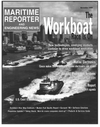
Page 92: of Maritime Reporter Magazine (November 1999)
Read this page in Pdf, Flash or Html5 edition of November 1999 Maritime Reporter Magazine
THE ONLY EVACUATION SYSTEMS THAT ARE OS COAST OIARR APPROVED. ijfVffjV ^ Evacuation Slide System. Designed specifically for Low Freeboard Ves-sels, it is a combination slide and platform. It provides speedy evacuation for all passengers - young, old and physically challenged. US Coast Guard Approved. Y* HflMHjH mm JflipB^^i i/ W^k KT -j Evacuation Chute System. The most efficient, easy-to-use, flexible, and cost-effective marine evacuation system avail-able in the world. It evacuates passengers and crew in the shortest possible time. Manufactured to meet or exceed all SOLAS requirements. US Coast Guard Approved We manufacture the only 100 person Reversible Inflatable Platform built in North America These sturdy platforms are designed for pas-senger carrying vessels operating in protected waters. Fully reversible - it offers instant board-ing, which ever way it inflates. Also available in 10, 25 and 50 person sizes. 101-3760 Jacombs Road, Richmond British Columbia, Canada V6V 1Y6 Ph. (604) 278-3221 Fx. (604) 278-7812 1-800-931-3221 Actoision of Dunlop-Beaufoft Canada Ltd. sa|esedbcmarine.com www.dbcmarine.com People & Company News MSC Celebrates 50 Years "MSC has been conspicuous because its peo-ple and ships generally have been where the action has been." Rear Adm. Bruce Keener III, USN Commander, Military Sealift Command, 1979-1981 Rear Adm. Keener made this observation on the U.S. Navy Military Sealift Command's 30th anniversary in October 1979. His words still hold true 20 years later as MSC, the ocean trans-portation specialists for the Department of Defense, celebrates its 50th anniversary. Today, MSC operates about 120 ships world-wide with 100 more ships in reserve status. What sets MSC ships apart from other Navy ships is all MSC ships are crewed by civil service or contract merchant mariners instead of active duty Navy people. Using civilian crews frees active duty Navy personnel for more traditional war-fighting assignments. MSC ships wear many hats for DOD. MSC Naval Fleet Auxiliary Force (NFAF) ships sup-port the U.S. Navy fleet around the world, pro-viding everything from fuel to food to ammuni-tion and towing services. NFAF ships keep the Navy's combatant ships at sea, on station and combat ready. MSC Special Mission ships provide many spe-cialized services for the Navy and the federal government including surveying the world's oceans and performing counter-drug operations. MSC Special Mission ships work with scientific and military commands to expand our knowl-edge of the world's oceans, combat drug smug-gling, monitor international compliance with strategic arms treaties and lay submarine cable. MSC Sealift ships transport military cargo and fuel quickly wherever they're needed to hotspots like the Balkans and remote areas such as Thule, Greenland. In the past year, MSC ships delivered aid to Hurricane Mitch-ravaged Central America, pro-vided logistics support during the Kosovo crisis and maintained a presence in places such as the Persian Gulf and the Indian Ocean. Today's MSC is an outgrowth of four different agencies that provided ocean transportation for the U.S. military through World War II: the Naval Transportation Service, the Army Trans-port Service, the U.S. Maritime Commission's War Shipping Administration and the Navy's Fleet Support Services. Following World War II, U.S. military leaders sought a better system. Military Sea Transporta-tion Service, MSC's name prior to 1970, was established on Oct. 1, 1949, to be the U.S. mili-tary's ocean transportation provider. The MSTS mission expanded in 1958 to include the operation of scientific support ships vessels involved in oceanographic research, mis-sile tracking, communications and other special missions. MSTS continued to define its role within the Navy and DOD in the 1960s. MSTS ships trans-ported people and supplies to and from South-east Asia during the Vietnam War. MSTS ships also supported the Apollo 11 mission to the moon in 1969. MSTS began the 1970s changing its name to Military Sealift Command. In 1972, MSC began operating its first Naval Fleet Auxiliary Force ship, civilian mariner-crewed fleet replenish-ment oiler USNS Taluga. Today, MSC operates about 30 NFAF ships working side-by-side with the U.S. Navy combatant fleet worldwide. The Ready Reserve Force, owned and main-tained by MarAd reduced operating status, but under MSC control when activated, was estab-lished in 1976. The RRF ships fill ocean trans-portation needs the commercial maritime indus-try may be unable to fill for the U.S. military during contingencies. In the 1980s, MSC introduced afloat preposi-tioning ships vessels laden with combat equip-ment and supplies and prepositioned at sea with-in several days sailing time of potential contin-gency areas. The seven initial Near Term Prepositioning Ships, operating near Diego Garcia in the Indian Ocean, were the forerunners to the Maritime Prepositioning Ships operated by MSC for the U.S. Marine Corps, which began service in 1984. The first Navy Combat Logistics Force ships built specifically for MSC operation, the Kaiser class fleet replenishment oilers, also began delivery in the 1980s. In addition, the Sirius class combat stores ships, purchased from the United Kingdom, joined the MSC force. MSC showcased its sealift and prepositioning capabilities in Operation Desert Shield in 1990-91. At the peak of strategic sealift activity, MSC operated 212 dry cargo ships and 22 tankers. Chief of Naval Operations Adm. Frank B. Kelso II, USN, awarded MSC a Navy Unit Commendation, MSC's first, for its execution of strategic sealift in support of the war. As a result of lessons learned from the Persian Gulf war and changing world dynamics after the fall of the Berlin Wall, DOD expanded afloat prepositioning and surge capabilities, building 19 large, medium-speed, RoRo ships for MSC operation. The last of the 950-ft. (289.5 m) behe-moths nearly as big as an aircraft carrier is scheduled for delivery to MSC is 2002. Throughout the 1990s, Navy leaders continued to transfer active duty crewed Combat Logistics Force ships to MSC operation. A total of seven Kilauea class ammunition ships and three Mars class combat stores ships are currently operated by MSC. Circle 328 on Reader Service Card Circle 390 on Reader Service Card Maritime Reporter/Engineering News

 91
91

 93
93
